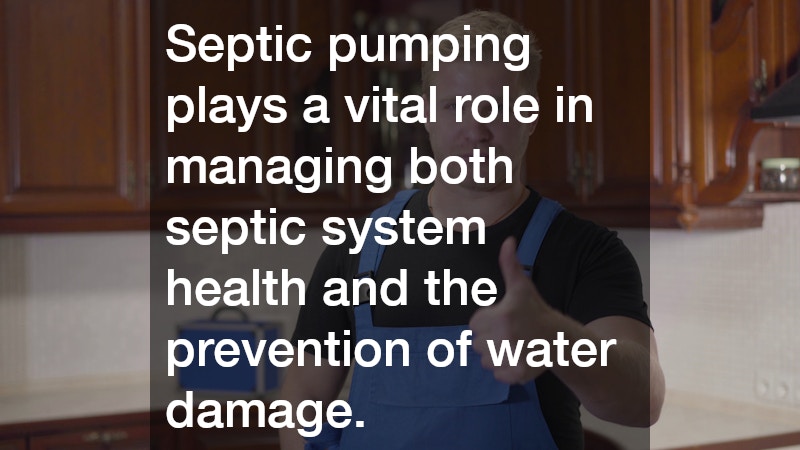In this article, we will explore the connection between septic pumping and water damage, shedding light on common concerns and questions. Septic systems are an essential component of many homes, providing a crucial function in managing wastewater. However, when these systems are not adequately maintained, they can pose serious risks not only to the system itself but also to the home and its occupants.
1. How Can Poor Septic System Maintenance Lead to Water Damage?
When septic systems are not regularly maintained or pumped, they can overflow or back up, leading to water damage in the surrounding areas. A clogged or overfilled septic tank can create pressure that forces waste materials into the plumbing and surrounding soil. This can result in unsanitary conditions, increased health risks, and extensive damage to property if not addressed promptly.
Moreover, the overflow of solid waste can saturate the ground near the septic system, leading to unpleasant odors and potential contamination of nearby water sources. Homeowners might notice brown patches of grass or standing water in their yard, indicating that the system is malfunctioning. Recognizing these signs early can prevent substantial issues and costly repairs.
In addition to visible signs of damage, poor septic system maintenance can lead to serious structural issues in a home. Saturated soil around the foundation can weaken the integrity of a house, leading to cracks and even foundation failure. It is crucial for homeowners to understand that neglecting septic pumping not only puts their immediate environment at risk but also undermines the very foundation upon which their homes stand.
2. What Are the Signs of a Failing Septic System?
Understanding the warning signs of a failing septic system can help homeowners prevent potential water damage before it occurs. One major indicator is the presence of slow drains in the home, which can signify a blockage in the septic system. If multiple drains are affected, it may be time to investigate the septic system’s health.
Another common sign is the unpleasant odor emanating from drain fields or near the septic tank. This odor indicates that waste materials are not being adequately processed and air is escaping, suggesting potential problems within the system. Ignoring these smells can lead to greater complications and increases the risk of water damage.
Visible signs in the yard, such as lush, green grass in certain patches or pooling water, can also signify a malfunctioning septic system. Healthy grass can indicate that waste is seeping into the soil, while pooling water suggests that the system is unable to absorb liquid properly. Homeowners should remain vigilant for these signs, as early detection can save significant time and money.
3. How Often Should Septic Systems Be Pumped to Prevent Water Damage?
Regular pumping is crucial for septic systems; this section will discuss recommended frequencies and how it helps mitigate water damage risks. Most experts recommend that septic systems be pumped every 3 to 5 years, though this timeline can vary based on the household’s size and usage. Factors such as the number of occupants and water usage habits can influence how often pumping is necessary.
Additionally, seasonal factors might affect the need for more frequent pumping. During heavy rains or periods of high water usage, the system may fill up more quickly, necessitating a pumping service sooner than anticipated. Homeowners should consult with professionals to establish a personalized maintenance schedule based on their usage and environmental factors.
By adhering to a regular pumping schedule, homeowners can prevent backups and overflows that lead to water damage. Understanding the cost-benefit relationship of regular maintenance can help homeowners realize that the price of pumping is far less than the cost of repairs from a failure. Regular attention to the septic tank ensures that it operates efficiently, allowing for the smooth processing of wastewater and reducing the risk of damaging water incursion.
4. What Should You Do If You Experience Water Damage Due to a Septic Backup?
Here we will outline steps to take immediately after experiencing water damage from a septic system failure, including mitigation and restoration tips. The first priority should be to ensure safety; avoid contact with the water and contaminated areas until the issue has been evaluated and assessed by professionals. It is crucial to stay calm and realize that immediate action can minimize damage.
Once safety has been secured, homeowners should promptly contact professionals who specialize in septic system services and water damage restoration. These experts can effectively assess the situation and provide guidance on the necessary steps for cleanup and repairs. Quick action can help prevent further water damage and potential health risks associated with sewage contamination.
In the aftermath of the incident, documentation of the damage will be essential for insurance claims. Taking photographs and keeping records of all communications and repairs completed can facilitate a smoother claims process. Homeowners must remain informed and proactive in ensuring that their septic systems are back in proper working order to prevent future incidents.
Septic pumping plays a vital role in managing both septic system health and the prevention of water damage. Regular maintenance is key to avoiding costly repairs. By understanding the intricate connections between septic systems and water damage, homeowners can take informed steps to care for their systems, ensuring a safe and healthy living environment.



